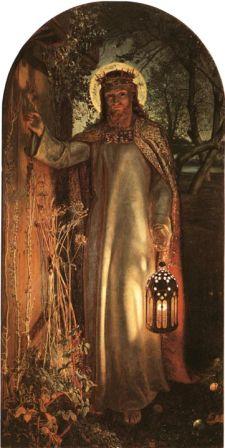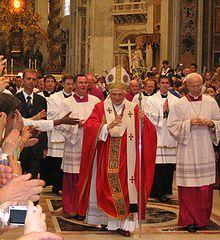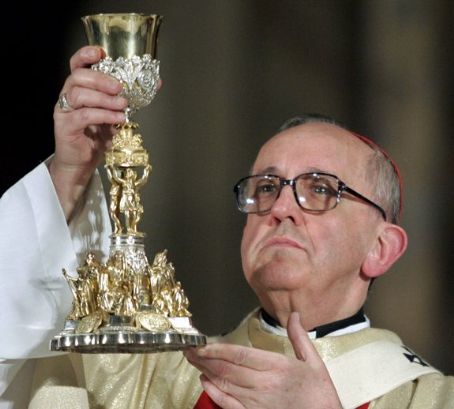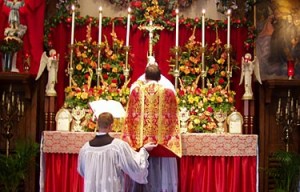 THE HOLY FAMILY ROSARY BROCHURE
THE HOLY FAMILY ROSARY BROCHURE
[The Scriptural texts of the Holy Family Rosary Mysteries in a printable color PDF file.]
INTRODUCTION
The purpose for this work is to provide a sure and steady means (a sturdy path, if you will) to learn of our obligation and purpose in creation which is to know, love and serve the Lord Our God with our whole heart, soul, mind and strength. We suggest that by meditating on these seven sets of five mysteries the truth of God the Father, God the Son and God the Holy Spirit can be easily realized in catechesis of our faith through the extension of the holy rosary meditations into a distinctly repetitive week of contemplative holy prayer. With the use of these meditations we are now offered a completely unique perspective to assist the discovery of the beginning of life and reason for our belief in God from the beginning of creation – thereby also allowing inclusion and contemplation of Mary’s conception and birth (as well as our own) in the mind and will of God before the beginning of time. Not coincidentally, the very last meditation in conclusion of these seven sets of mysteries returns us to our looking ahead towards heaven on the New Sabbath with contemplation and hope of bearing witness in adoring attestation of the Coronation of Mary as Queen.
What we hope you will find within these extended Rosary meditations are a logical reflection of the main historical accounts of God’s Good News that will allow you an ordinary vehicle to easily approach Our Lord in expectation, experience and knowledge of the goodness of God by prayerfully pondering the love of God’s Son, born and especially nurtured, within His Beloved Mother’s Immaculate Heart – all with God’s Holy Word foretelling of “In the beginning” [Gen 1:1] of the imminent Immaculate Conception of Mary [Gen 3:15] at creation’s dawn.
For the past two millenniums those who have sought, found and attained the personal experience of walking in the peaceful love of God have steadfastly attested that our path to truth was revealed by the life, death and resurrection of the Son of God as Our Lord and Savior, Jesus Christ. They faithfully affirm that the perfection of life firmly begins in our belief that Jesus Christ is the authentically perfect image of God and, as begun in the New Testament Gospel of Jesus Christ according to St. John, that: “In the beginning was the Word, and the Word was with God, and the Word was God.” [Jn 1:1].
These reflections are offered in direct response to the Apostolic Letter Rosarium Virginis Mariae of St. Pope John Paul II (b.1920, Papacy:1978-d.2005) that was published on October 16, 2002, when His Holiness introduced the Luminous Mysteries and asked the clergy, religious and faithful lay Catholics to “promote greater use of the Rosary as Mary’s school of prayer into a fuller compendium of the gospel.” By offering these recurring seven days of contemplative prayer with Mary, we are introduced to a very firm foundation for recollection of certain historical events in catechesis of the knowledge and reason for our faith in Jesus Christ, the foretold Son of David and Son of God.
You will find that what was first presented here during the “Year of Faith” now advances the “New Evangelization” after the “Jubilee Year of Mercy” in supporting validation of the importance of our participation within the sacramental life of Christ’s Church. This proposed work accentuates a week of holy reflection when employed with the three original Joyful, Sorrowful and Glorious Mysteries of the Holy Rosary in addition to the Luminous Mysteries introduced by St. Pope John Paul II. They are designed to inspire a good and reasonable means to sustain our faith beyond daily Mass to live in the manner of the psalmist’s proclamation: “Every day will I bless thee: and I will praise thy name for ever; yea, for ever and ever”[1] for each day of every week.
The following list details the seven sets of mysteries in order with further explanation and are named the…
These meditations help us recognize God’s ordaining of seven days as the natural reflection of His perfect spiritual order. Six days of labor followed by a day of rest. In this format, the person of Jesus as the Son of Mary and Son of God, compels us to study how the mysteries of faith, hope, and charity are dispensed to man from God the Father, through God the Son, in the unity of God the Holy Ghost; confirming the Essence of God’s Presence in the Holy Trinity – Three in One.
 With the introduction of the Luminous Mysteries it was easy to recognize how three additional sets of meditations based upon the Mother of Jesus’ faithful view of mercy, grace and faith could be combined with the original Joyful, Sorrowful, and Glorious Mysteries of the Holy Rosary into a fuller compendium of the gospel. It is given in direct response to the same Apostolic Letter Rosarium Virginis Mariae in which St. John Paul II said: “What is needed is a Christian life distinguished above all in the ‘art of prayer.’ Inasmuch as contemporary culture, even amid so many indications to the contrary, has witnessed the flowering of a new call for spirituality, due also to the influence of other religions, it is more urgent than ever that our Christian communities should become `genuine schools of prayer.’”
With the introduction of the Luminous Mysteries it was easy to recognize how three additional sets of meditations based upon the Mother of Jesus’ faithful view of mercy, grace and faith could be combined with the original Joyful, Sorrowful, and Glorious Mysteries of the Holy Rosary into a fuller compendium of the gospel. It is given in direct response to the same Apostolic Letter Rosarium Virginis Mariae in which St. John Paul II said: “What is needed is a Christian life distinguished above all in the ‘art of prayer.’ Inasmuch as contemporary culture, even amid so many indications to the contrary, has witnessed the flowering of a new call for spirituality, due also to the influence of other religions, it is more urgent than ever that our Christian communities should become `genuine schools of prayer.’”
About the Mysteries of Faith, Hope, and Charity
Because of the timeliness of the Luminous Mysteries, we can readily discern how the Light of Christ acts as a continually renewing contemporary bridge between the Old and New Testaments. The Person of Jesus Christ gave us a new perspective of the Old Testament through His teachings, much in the same way that we see the newly unfolding practical acceptance of both the ordinary and extraordinary (assigned names of the old and new) forms of the Sacrifice of the Mass. His Holiness Pope (now Emeritus) Benedict XVI desired the traditional liturgy to become accessible and not hidden from stable faithful Catholics who are attached to the traditional “Tridentine” Roman rite, in like manner as Christ Himself insisted by His teaching that He came – not to abolish – but to fulfill the law.
In the Apostolic Letter “Summorum Pontificum” issued Motu Propio, Pope Benedict XVI had stated: “Since time immemorial it has been necessary – as it is also for the future – to maintain the principle according to which each particular Church must concur with the universal Church, not only as regards the doctrine of the faith and the sacramental signs, but also as regards the usages universally accepted by uninterrupted apostolic tradition, which must be observed not only to avoid errors but also to transmit the integrity of the faith, because the Church’s law of prayer corresponds to her law of faith.” Within harmonious instructions that we are “church,” we must all be personally held bound by this same reasoning of our faith.
He continued: “The Roman Missal promulgated by Paul VI is the ordinary expression of the ‘Lex orandi’ (Law of prayer) of the Catholic Church of the Latin rite. Nonetheless, the Roman Missal promulgated by St. Pius V and reissued by St. John XXIII is to be considered as an extraordinary expression of that same ‘Lex orandi,’ and must be given due honor for its venerable and ancient usage. These two expressions of the Church’s Lex orandi will in no way lead to a division in the Church’s ‘Lex credendi’ (Law of belief). They are, in fact two usages of the one Roman rite.”
LEX VIVENDI
In response to the spiritual needs of the pilgrim members of Christ’s one, holy, catholic, and apostolic Church, these meditations support Pope Benedict’s encyclicals on Faith and Hope and encourage living our personal responsibilities within this “law of prayer” and “law of belief.” By making an accounting of ourselves and our faith to all men of all nations, the year dedicated to the Apostle St. Paul was concluded in renewed anticipation of the beginning of the Year of Priests in “Lex vivendi” for the restoration of personal holiness and renewed interest in holy families as our “law of living.”
More recently, according to an online post of the National News Agency (CNA/EWTN News) in Palermo, Italy, on October 3rd, 2010, it was reported: “At noon on Sunday, Pope Benedict prayed that all people might be strengthened in faith, hope and charity through the intercession of Mary. He asked in particular, that she lead the faithful to ‘walk quickly and joyfully on the way of holiness.”’
The Catholic News Agency also included: “Remembering the concurrent celebration of the beatification of Anna Maria Adorni in Parma, Italy on Sunday, her devotion to saying the Rosary and the beginning of the Marian month of October, the Holy Father prayed that the ‘daily meditation of the mysteries of Christ in union with Mary, the “praying Virgin”, might fortify us all in faith, hope and charity.'”
 In Assisi, Italy, on November 9, 2010 (Zenit.org), Pope Benedict XVI urged greater appreciation of the liturgy as a source of education about the “good life of the Gospel. The rites speak through their intrinsic rationality,” the Pontiff noted, “and educate to a conscious, active and fruitful participation” and, as in earlier directives, he continued, “The correspondence of the prayer of the Church (lex orandi) with the rule of the faith (lex credendi) molds the thought and the feelings of the Christian community, giving shape to the Church, Body of Christ and Temple of the Spirit.”
In Assisi, Italy, on November 9, 2010 (Zenit.org), Pope Benedict XVI urged greater appreciation of the liturgy as a source of education about the “good life of the Gospel. The rites speak through their intrinsic rationality,” the Pontiff noted, “and educate to a conscious, active and fruitful participation” and, as in earlier directives, he continued, “The correspondence of the prayer of the Church (lex orandi) with the rule of the faith (lex credendi) molds the thought and the feelings of the Christian community, giving shape to the Church, Body of Christ and Temple of the Spirit.”
“No human word can do without time, even when, as in the case of the liturgy, it constitutes a window that opens beyond time,” the Holy Father affirmed. “Hence, to give voice to a perennially valid reality calls for the wise balance of continuity and novelty, of tradition and actualization.” And explained, “The whole Church is present in every liturgy: to adhere to its form is the condition of the authenticity of what is celebrated.”
“May this reason drive you,” he continued, “in the changing conditions of the time, to make ever more transparent and practicable that same faith that dates back to the age of the nascent Church.” [For this reason alone, he is encouraging that what is new must co-exist in a living respect of the older traditions to maintain an harmonious accord within a world of progressively rapid change.]
“The genuine believer, in every age, experiences in the liturgy the presence, the primacy and the work of God,” the Pontiff said, and continues to speak of the Mass as, “…veritatis splendor, nuptial event, foretaste of the new and definitive city and participation in it; it is a link of creation and of redemption, open heaven above the earth of men, passage from the world to God; it is Easter, in the cross and in the resurrection of Jesus Christ; it is the soul of the Christian life, called to follow, to reconciliation that moves to fraternal charity.”
The Holy Father then affirmed that, “The holiness of the Eucharist exacts that this mystery be celebrated and adored conscious of its greatness, importance and efficacy for Christian life, but it also calls for purity, coherence and holiness of life from each one of us, to be living witnesses of the unique sacrifice of love of Christ.” [Hence tradition, scriptures, and the Magisterium must be co-equally valued in faithful participation in the image of God.]
What will be seen as “new” within the practice of these meditations is their expansion of the use of the holy rosary as a catechesis tool and within this same well-intentioned expression for both prayer and belief, they draw closer contemplation of God’s forgiveness and mercy by the charitable reconciliation offered through the faithful image of Christ in His Church – all viewed through and with Mary – and all neatly accomplished and summarized within a holy week in factual exposition and participatory explanation of the Sacramental Church. Without doubt, the weekly practice of contemplating these seven sets of mysteries establishes a wonderful “Lex vivendi” (law of living) that our world cries out to see.
 Even more recently posted on May 24, 2013, in a blog by , a prayer to Mary was recited by His Holiness Pope Francis for all the Italian bishops meeting in plenary session (…) saying: “I place you, and I place myself, too, under the mantle of Mary, Our Mother”, and concluded with…
Even more recently posted on May 24, 2013, in a blog by , a prayer to Mary was recited by His Holiness Pope Francis for all the Italian bishops meeting in plenary session (…) saying: “I place you, and I place myself, too, under the mantle of Mary, Our Mother”, and concluded with…
“Mother of the silence that preserves the mystery of God, deliver us from the idolatry of the present, to which those who forget are condemned. Purify the eyes of pastors with the balm of memory: that we might return to the freshness of the beginning, for a praying and penitent Church.
Mother of the beauty that blossoms from fidelity to daily work, remove us from the torpor of laziness, of pettiness, and defeatism. Cloak Pastors with that compassion that unifies and integrates: that we might discover the joy of a humble and fraternal servant Church.
Mother of the tenderness which enfolds in patience and mercy, help us burn away the sadness, impatience, and rigidity of those who have not known what it means to belong.
Intercede with your Son that our hands, our feet and our hearts may be swift: that we may build the Church with the truth in charity.
Mother, we will be the People of God, on pilgrimage towards the Kingdom. Amen.”
This being said with the acknowledgment that there is no coincidence in God, we pray that one day His Holiness Pope Francis will find these meditations worthy of approval and confirm to the world that what we believe to be Mary’s predestined perspective from before creation until her being crowned Queen of Heaven and Earth acknowledges her example of faith, hope, and charity for us – and is truly in fact a glorious perspective of God through Mary’s Immaculate Conception and Heart. Just as “I Believe” promotes our faith in God the Father, Son and Holy Ghost, and assists our quickened response towards this ages’ tumultuous need for restoration, we must renew our concern for personal sanctity through faithful prayer to “Our Father” and accompany our remembrance of penance and joyful alms-giving with each “Hail Mary” to willfully lead us to live in God’s eternal world without end. Amen, amen. And again, amen indeed![2]
[1] Ps. 144:2. (Douay-Rheims English Translation of the Latin Vulgate Bible.)
[2] Excerpt from The Holy Family Rosary; Copyright © 2002 by John of the fallen cross.
ALL RIGHTS RESERVED. Printed in the United States of America.
No part of this publication may be reproduced, stored in a retrieval system, or transmitted in any form or by any means, electronic or mechanical, including photocopying, recording, or otherwise without prior written permission from the publisher.


